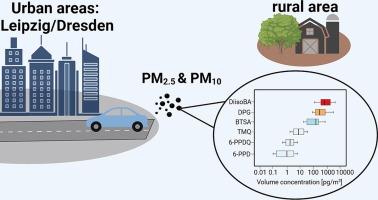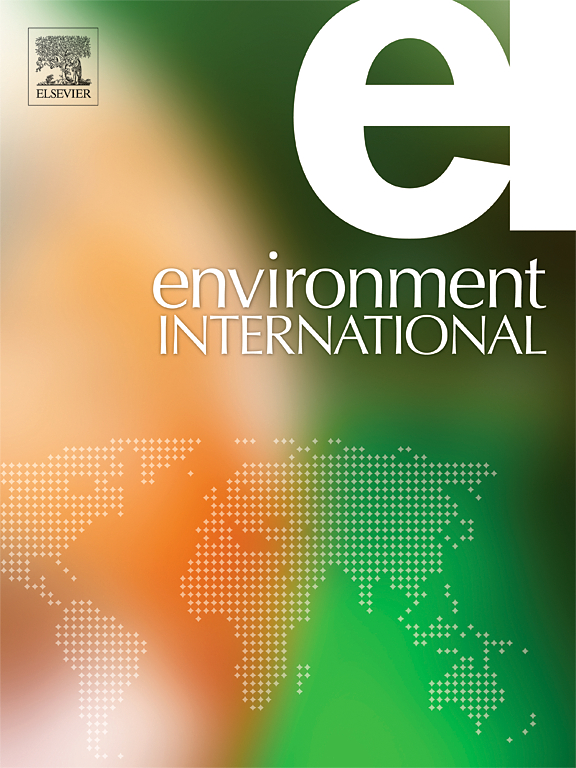Quantification and occurrence of 39 tire-related chemicals in urban and rural aerosol from Saxony, Germany
IF 10.3
1区 环境科学与生态学
Q1 ENVIRONMENTAL SCIENCES
引用次数: 0
Abstract
Tire and road wear particles (TRWP) are a major contributor to non-exhaust traffic emissions, but their contribution to and dynamics in urban aerosol is not well known. Urban particulate matter (PM) in the size fraction below 10 µm (PM10) from two German cities was collected over 2 weeks and analysed for 39 tire-related chemicals, including amines, guanidines, ureas, benzothiazoles, p-phenylenediamines, quinolines and several transformation products (TPs). Of these, 37 compounds were determined in PM10 at median concentrations of 212 pg/m3 for 1,3-diphenylguanidine (DPG) and 132 pg/m3 for benzothiazole-2-sulfonic acid (BTSA); 10 of the compounds have not been reported in urban aerosol before. Median concentrations of N-(1,3-dimethylbutyl)-N′-phenyl-p-phenylenediamine (6-PPD), 6-PPD quinone (6-PPDQ), and 1,2-dihydro-2,2,4-trimethylquinoline (TMQ) were 1.0, 4.1, and 8.1 pg/m3, respectively. Some parent compounds showed positive correlation with their TPs, e.g. 6-PPD with 4-aminodiphenylamine (4-ADPA), N,N’-diphenyl-p-phenylenediamine (DPPD) with DPPD quinone (DPPDQ), and DPG with phenylguanidine (PG). The concentration pattern of the compounds in PM10 did not agree to the pattern found for cryo-milled tire tread (CMTTmix), likely reflecting transformation processes in tires or the aerosol and the influence from other sources than TRWP. Concentrations in PM2.5 were determined from one of the sites and were by a factor of 4 – 10 lower than in PM10-2.5 for 9 compounds, but a few others, mostly benzothiazoles showed similar or higher concentrations. Many of the tire-related chemicals were also determined in PM10 of one rural site, although at median concentrations up to two orders of magnitude lower. A large number of tire chemicals with a wide concentration range is present in urban PM10 and PM2.5 aerosol and requires scrutiny with respect to its relevance for human exposure.


德国萨克森州城市和农村气溶胶中39种与轮胎有关的化学物质的量化和发生
轮胎和道路磨损颗粒(TRWP)是非废气交通排放的主要贡献者,但它们对城市气溶胶的贡献和动态尚不清楚。在2 周内收集了两个德国城市小于10 µm (PM10)的城市颗粒物(PM),并分析了39种与轮胎相关的化学物质,包括胺、胍类、脲类、苯并噻唑、对苯二胺、喹啉类和几种转化产物(tp)。其中,在PM10中检测到37种化合物,其中1,3-二苯基胍(DPG)和苯并噻唑-2-磺酸(BTSA)的中位浓度分别为212 pg/m3和132 pg/m3;其中10种化合物以前未在城市气溶胶中发现。N-(1,3-二甲基丁基)-N′-苯基-对苯二胺(6-PPD)、6-PPD醌(6-PPDQ)和1,2-二氢-2,2,4-三甲基喹啉(TMQ)的中位浓度分别为1.0、4.1和8.1 pg/m3。6-PPD与4-氨基二苯胺(4-ADPA)、N,N′-二苯基-对苯二胺(DPPD)与DPPD醌(DPPDQ)、DPG与苯胍(PG)等亲本化合物与TPs呈正相关。PM10中化合物的浓度模式与冷磨轮胎胎面(CMTTmix)的模式不一致,可能反映了轮胎或气溶胶的转化过程以及TRWP以外的其他来源的影响。其中一个监测点的PM2.5浓度比PM10-2.5低4 - 10倍,但其他一些化合物(主要是苯并噻唑)的浓度相似或更高。在一个农村地区的PM10中也检测到许多与轮胎有关的化学物质,尽管其中位数浓度要低两个数量级。城市PM10和PM2.5气溶胶中存在大量浓度范围广的轮胎化学品,需要仔细研究其与人类暴露的相关性。
本文章由计算机程序翻译,如有差异,请以英文原文为准。
求助全文
约1分钟内获得全文
求助全文
来源期刊

Environment International
环境科学-环境科学
CiteScore
21.90
自引率
3.40%
发文量
734
审稿时长
2.8 months
期刊介绍:
Environmental Health publishes manuscripts focusing on critical aspects of environmental and occupational medicine, including studies in toxicology and epidemiology, to illuminate the human health implications of exposure to environmental hazards. The journal adopts an open-access model and practices open peer review.
It caters to scientists and practitioners across all environmental science domains, directly or indirectly impacting human health and well-being. With a commitment to enhancing the prevention of environmentally-related health risks, Environmental Health serves as a public health journal for the community and scientists engaged in matters of public health significance concerning the environment.
 求助内容:
求助内容: 应助结果提醒方式:
应助结果提醒方式:


